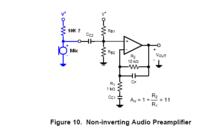Ebonic
Junior Member level 2
Hi all
Having trouble configuring this op-amp in my project.And get it to work correctly.
**broken link removed**
Using op-amp LMV796 from TI.
In a Non-inverting configuration.And it must be in the Non-inverting configuration
So the signal does not attenuate from the electret Mic.
The circuit is in figure 10 in the Datasheet.
I'm using a power supply of 3.6V to power the amp.
I want to use a variable pot for a gain of 0-20.
Then i want to connect the amp to a 9170 DTMF decoder.

Having trouble configuring this op-amp in my project.And get it to work correctly.
**broken link removed**
Using op-amp LMV796 from TI.
In a Non-inverting configuration.And it must be in the Non-inverting configuration
So the signal does not attenuate from the electret Mic.
The circuit is in figure 10 in the Datasheet.
I'm using a power supply of 3.6V to power the amp.
I want to use a variable pot for a gain of 0-20.
Then i want to connect the amp to a 9170 DTMF decoder.



